Hazelnut Macarons
Hello friends! Today we are making Hazelnut Macarons, filled with a Hazelnut German Buttercream.
Make sure to watch the video on this page or on YouTube, showing you exactly how to make these awesome delicious Hazelnut Macarons.
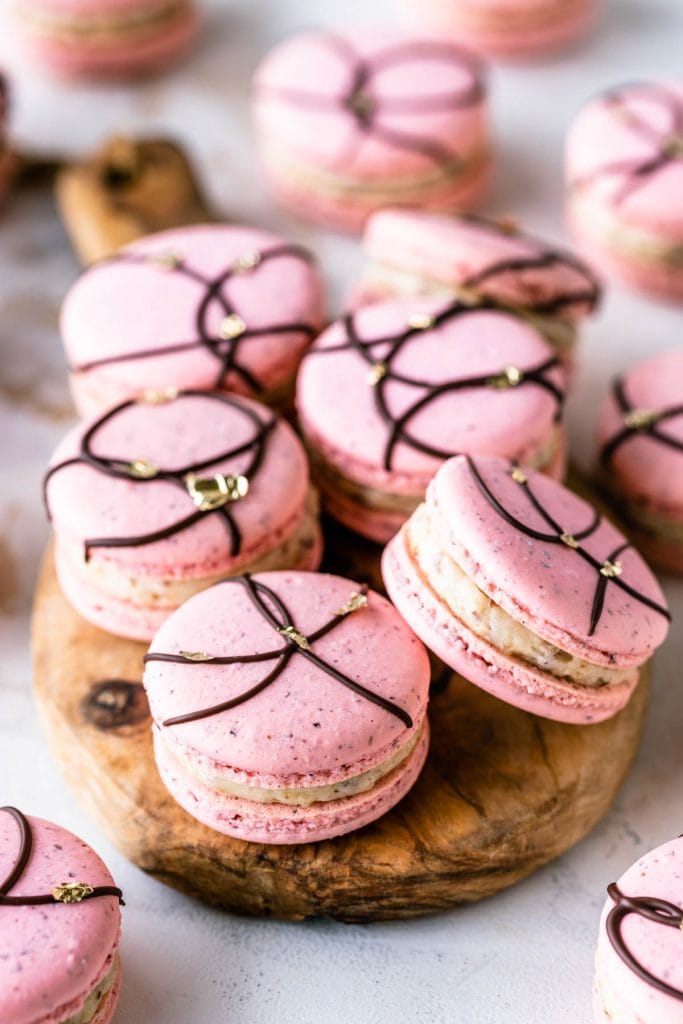
As you can see the shells are speckled, because I chose to use hazelnut flour to make these macarons.
This post may contain affiliate links. I earn a commission from qualified purchases. Please read our Privacy policy here.
On my first experiment I used only hazelnut flour in place of the almond flour. The results were not very satisfactory. The macarons had a huge gap between the feet and the top. I wasn’t too pleased.
So for this time around, I decided to substitute only 1/3 of the usual amount of almond flour for hazelnut flour.
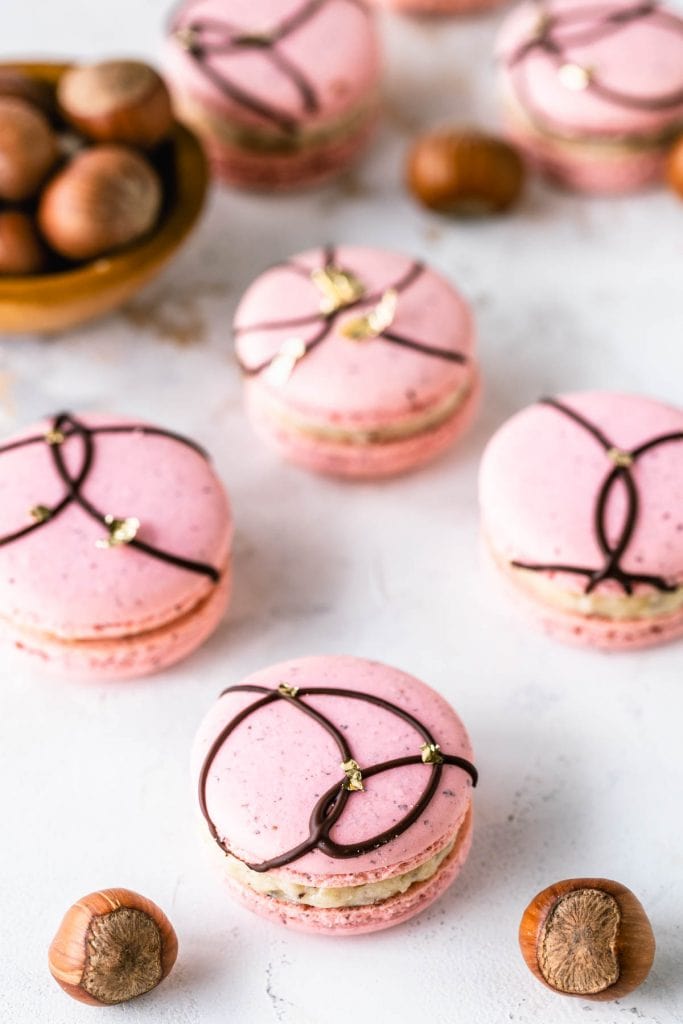
One of the biggest tips I can give you when making these hazelnut macarons is to sift the hazelnut flour BEFORE measuring it.
I had to sift about 60 grams of hazelnut flour to obtain 30 grams of hazelnut flour that would be fine enough to be used in the macarons.
If the flour you are using in the macarons is too coarse, you will run into some issues:
- thick batter that won’t flow
- the macarons might have a weird shape as you pipe them, since they won’t settle into a nice smooth circle
- feet that separate from the top of the shell
- bumpy shells
This is the hazelnut flour I used, and even though it claims to be finely ground, it really wasn’t. But it’s ok because since I measured after sifting, I was able to obtain a really fine flour after all.
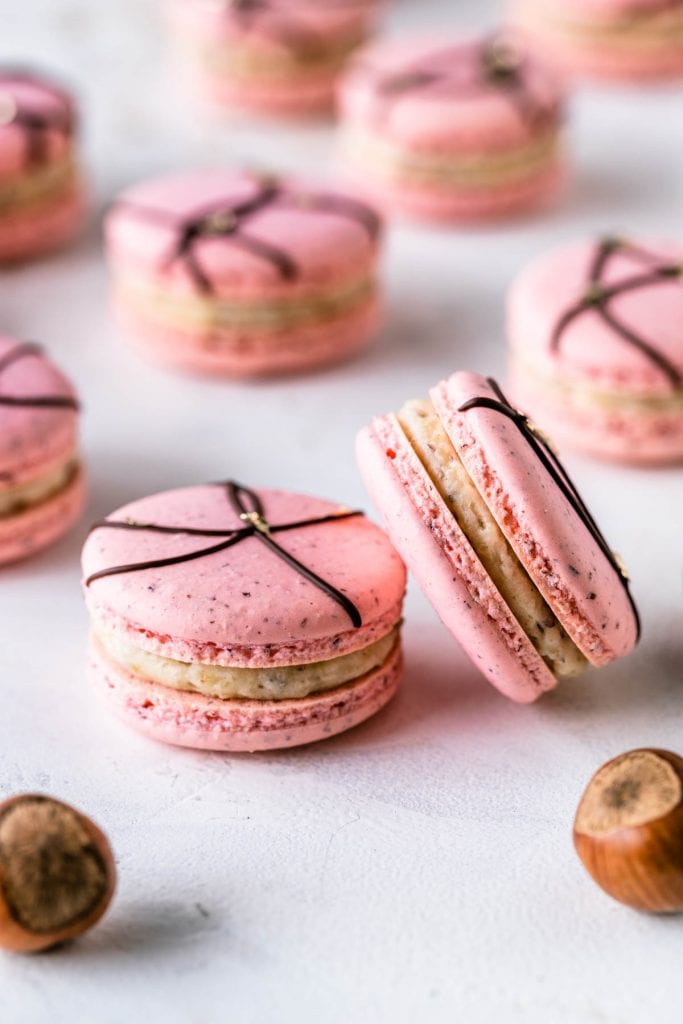
Because of the fact that I used hazelnut flour to make the hazelnut macaron shells, it made the batter a bit thicker than if I was using just almond flour.
Initially I continued to fold because I thought I wasn’t getting to the right consistency, when I realized it was just a thicker batter by nature.
So this is definitely something to have in mind. The fact that this batter is thicker than what you might be used to if you’re a regular almond flour macaron baker such as myself.
As long as you can draw a couple of figures 8s with the batter that’s falling off the spatula, and then after the batter breaks up, it still continues to flow slowly off the spatula, incorporating back with the batter that’s on the bowl, you should be good to go.
In any case, watch my video on this page or on YouTube, which will show you exactly what kind of consistency you should be looking for.
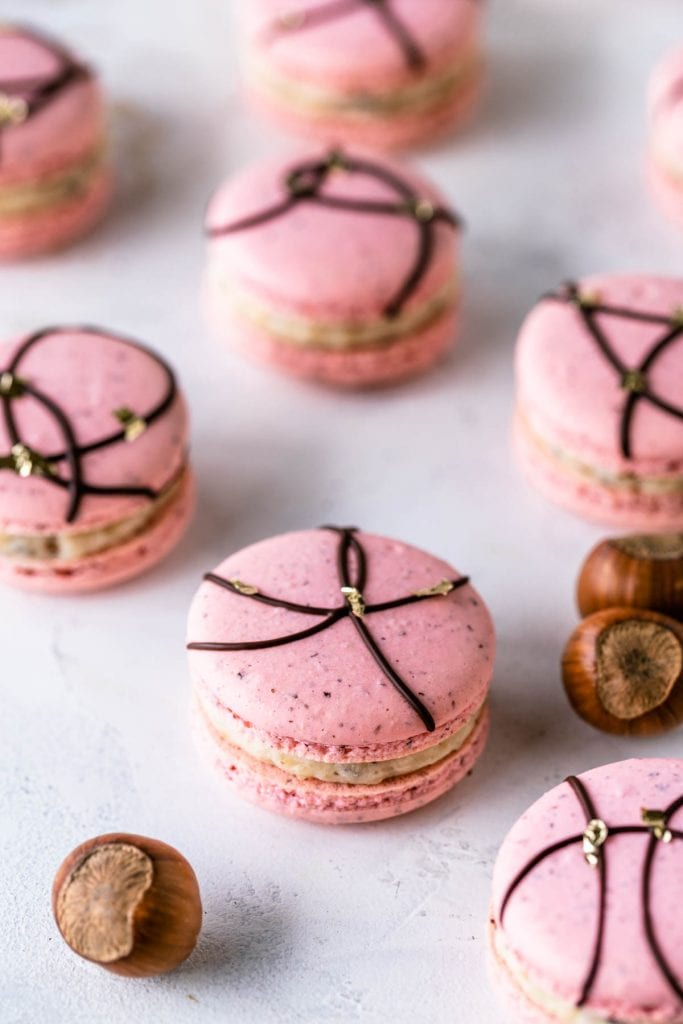
Most times when I see Hazelnut Macaron recipes out there, they all involve Nutella or chocolate. This time I wanted to keep the filling and the shells chocolate free, even though I did use chocolate to decorate the top of the shells, but as far as the cookie itself, I didn’t want to use chocolate in it.
So I went for a German Buttercream.
I love making this type of buttercream. It starts with a custard. I made a Hazelnut Custard, and then used it to make the Hazelnut German Buttercream.
It’s super easy to make, not overly sweet, and lets the taste of the hazelnuts really shine.
German Buttercream is super smooth and velvety, it totally melts in your mouth when you eat it. It’s amazing!
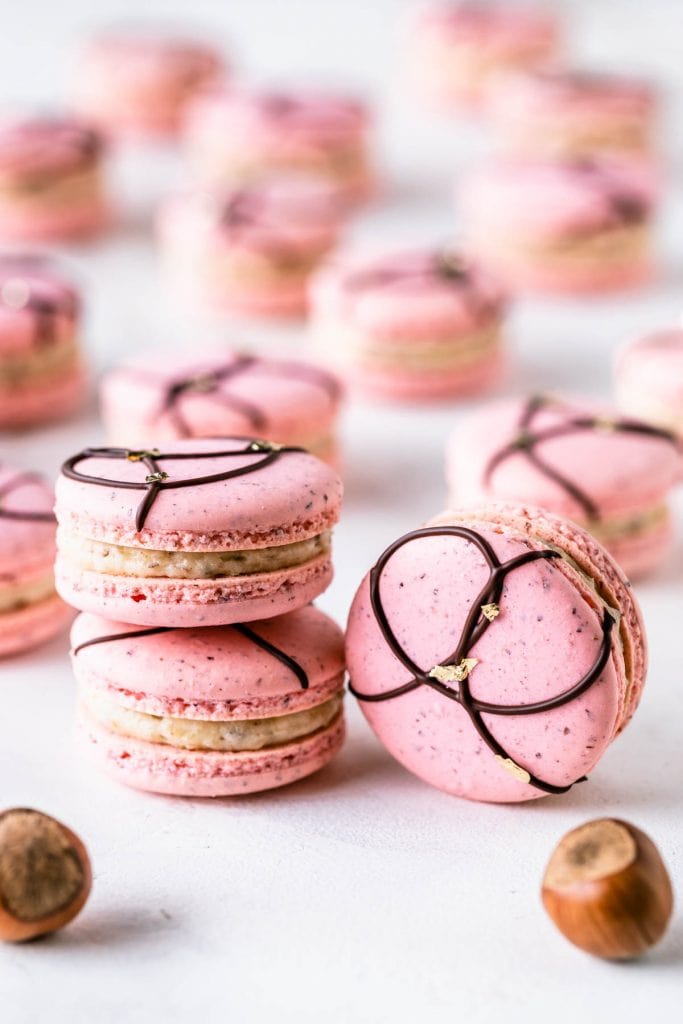
If you liked these Hazelnut Macarons, here are some more recipes you may enjoy:
- Cinnamon Roll Macarons
- Fig Macarons
- Peanut Butter Chocolate Macarons
- Coconut Macarons
- White Chocolate Macadamia Macarons
- Pecan Turtle Macarons
- Nutella Macarons
- Dulce de Leche Pecan Macarons
- Coffee Macarons
- Salted Caramel Macarons
- Pistachio Macarons
- Chocolate Macarons
You can find my complete list of macaron flavors and ideas here.
If you are learning how to make macarons, the resources on my page Macaron School might help you out, so make sure to check it out. You will find a compilation of tips, tricks, scientific explanations, troubleshooting guides, and much more information to help you up your macaron game!
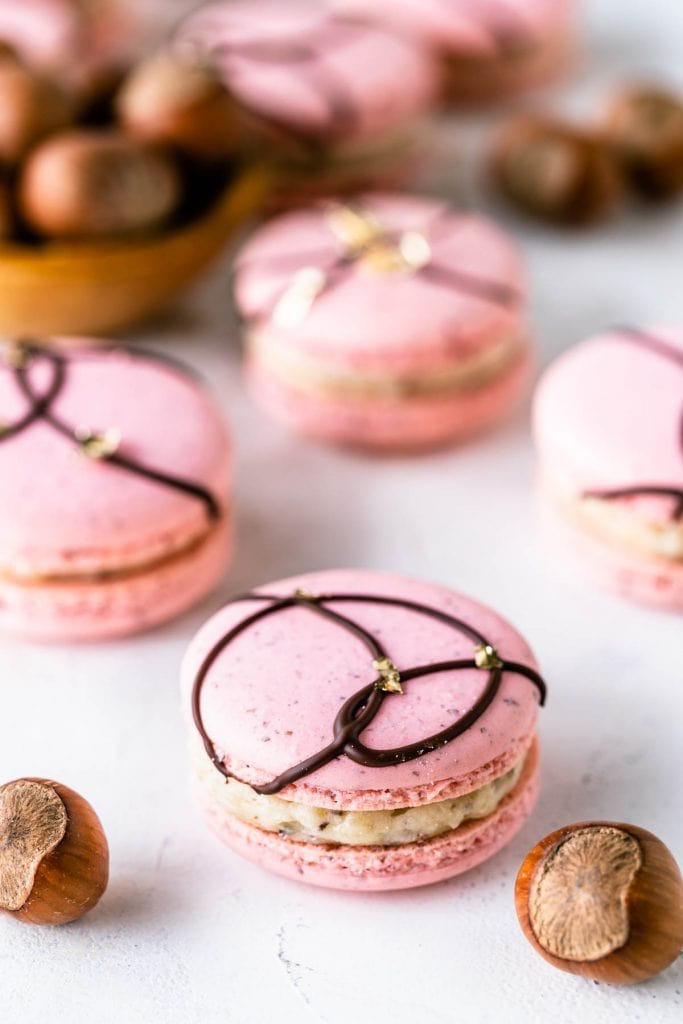
If you make these Hazelnut Macarons tag me on instagram, or leave a review below, I love hearing from you!
Thanks for reading!
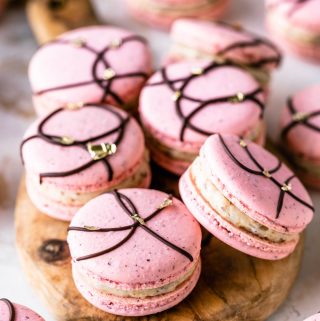
Hazelnut Macarons
Ingredients
Hazelnut Macaron Shells
- 4 grams egg white powder optional, read notes
- 100 grams granulated sugar
- 100 grams egg whites
- 30 grams hazelnut flour
- 75 grams almond flour
- 100 grams powdered sugar
- Food coloring I used pink
Hazelnut Custard
- 1/3 cup milk
- 1/4 cup granulated sugar divided (50 grams)
- 1 large yolk
- 1 tbsp cornstarch
- 1/2 cup ground hazelnuts 65 grams
- 1/2 tsp vanilla
- 1 tsp unsalted butter
Hazelnut German Buttercream
- 1 to 1 1/2 cups powdered sugar 125 to 187 grams
- 1/4 cup unsalted butter room temperature (56 grams)
- 1/2 cup Hazelnut Custard recipe below
To decorate
- 1 oz dark chocolate optional
- Edible gold leaves optional
Instructions
Hazelnut Macaron Shells
- Before you start, get all of the ingredients ready. Prepare a large piping bag, fitted with a large round tip, I use a 1/2” diameter tip. Set aside.
- Line two baking sheets with parchment paper or silicone mat.
- Measure out all of the ingredients.
- Sift the hazelnut flour. Measure the hazelnut flour after sifting it, because hazelnut flour tends to be very lumpy, and you want to make sure you’re using only the very fine crumbs. Which is why it’s important to measure it only after sifting. I needed about double of the amount of hazelnut flour to obtain 30 grams of finely sifted flour.
- Combine the sifted and measured hazelnut flour with the almond flour, and powdered sugar, and sift them together. Set it aside.
- Whisk the sugar and the egg white powder (if using) in a bowl, and place it over a pan with barely simmering water. Add the egg whites to the sugar and whisk the mixture until frothy and the sugar is completely melted. It will take a couple of minutes. You can test by touching the mixture between your fingers, and if you feel any sugar granules just keep whisking the mixture over the water bath.
- Make sure the bottom of the bowl isn’t touching the simmering water because you don’t want the whites to cook.
- Also, don’t overheat the sugar syrup, this may cause issues down the line, such as wrinkly macarons.
- Transfer the syrup to the bowl of a stand mixer.
- With the whisk attachment, start whisking mixture on low for about 30 seconds, then gradually start increasing speed to medium. Whisk on medium for one to two minutes, until the mixture is white and starting to become fluffy. Raise the speed to high, or medium-high and whisk for a few minutes until stiff peaks are formed. Best way to check this is to keep your eye on the whites. Once they get glossy and you start seeing streaks formed by the whisk, it might be time to stop.
- Whisk until stiff peaks have formed. When you pull your whip up, the peak should be stiff and shooting straight up, with possibly a slight bend at the top, but not bending down to the side.
- Pour the sifted powdered sugar, almond flour, and hazelnut flour into the stiff meringue.
- Start folding gently forming a letter J with a spatula.
- Add the food coloring at this point, if using. I’ve added a touch of pink gel food coloring.
- How to know when to stop folding the batter: It’s time to stop folding when the batter is glossy and has a thick and flowing consistency. There are several ways to test this.
- If you are used to making regular almond flour macarons, you will notice that the hazelnut macarons have a thicker batter, and won’t flow as effortless as the almond flour ones. The hazelnut flour will make for a thicker, and sort of lumpy batter, not as smooth as the only almond flour batter.
- So the way to test if the batter is ready is pretty much the same as the almond flour macaron batter, only a bit thicker, less flowy.
- First, pick up some batter with the spatula and try to draw a figure 8 with the batter that is dripping off the spatula. If you can form just a couple of figure 8s without the batter breaking up, that’s one indication that it might be ready.
- There’s another test you can do. I call it the Teaspoon test.
- Grab a teaspoon of batter and spoon onto the parchment paper or silicon mat. Wait a minute to see how it behaves.
- If the batter stays stiff, forming a point and doesn’t spread out, fold a little bit more, about 3 folds.
- Test again.
- Once the batter spreads out a bit and starts to look glossy and smooth on top, on the parchment paper, it’s ready.
- You don’t want your batter to be too runny either. So be careful not to overmix. It’s always best to undermix and test several times until the proper consistency has been achieved.
- When you hold the spatula with batter on top of the bowl and the batter falls off the spatula slowly but effortlessly the batter is ready. The batter will keep flowing off the spatula non-stop, but not too quickly.
- Transfer the batter to the piping bag.
- Place the piping bag directly 90 degrees over the center of each macaron template. Apply gentle pressure and carefully pipe for about 3 seconds, and then quickly pull the bag up twisting slightly.
- Once you’ve piped as many circles as you could, bang the trays against the counter a few times each.
- Use a toothpick to pop any air bubbles in the surface of the shells.
- Let the trays sit for a while so the shells will dry out a little bit. I usually leave about 20-40 minutes, depending on how humid the day is. You’ll know they’re ready when you gently touch the surface of a macaron and it seems dry.
- Pre-heat the oven to 300ºF.
- Bake one tray at a time.
- Bake for 5 minutes, rotate tray.
- I bake each tray for about 15 to 20 minutes.
- When baked, the macarons will have a deeper color and formed feet. If you try to move a macaron, it shouldn’t feel jiggly. If the macaron is still jiggly, keep baking.
- Remove from the oven and bake the other tray.
- Let the macarons cool down before proceeding with the filling.
Hazelnut Custard
- Place the milk and 2 tbsp of sugar in a small saucepan, over medium heat, and bring it to almost a boil. Make sure to turn the heat off before it actually comes to a boil. The sugar should be melted with the milk. Meanwhile, whisk the egg yolk with the remaining 2 tbsp of sugar and 1 tablespoon of cornstarch, until lightened in color.
- Slowly pour about a couple of tablespoons of the milk over the yolk mixture, while whisking non-stop. This is called tempering the egg, and it means to slowly add the hot mixture to the yolk so it doesn’t cook it. Keep adding the remaining milk very slowly, while whisking the custard. Once all the milk has been added to the yolk, return the whole mixture to the saucepan that you used to heat the milk by pouring through a strainer, to retain any bits of yolk that may have cooked.
- Add the ground hazelnut to the custard. Place the pan over medium heat and start cooking, while stirring non-stop. Keep heating the mixture and mixing it with a wooden spoon or spatula, making sure to scrape the sides and bottom very well while you cook it. The custard will start to get thick and it will look lumpy for a while, just keep stirring over medium heat. After a couple of minutes the mixture should be thick like a cream, and smooth. At this point, remove the pan from the heat, and add the vanilla extract, and unsalted butter to the custard. Pour it in a small bowl, cover it with a plastic wrap, placed right on the surface of the custard, so it doesn’t form a skin as it cools. Place it in the fridge to chill completely.
Hazelnut German Buttercream
- Start by sifting the powdered sugar, and set it aside.
- Place the butter in the bowl of an electric mixer, and cream at medium-high speed for 2 minutes. Add 1/2 cup of the chilled Hazelnut Custard to the mixer and cream it with the butter for 45 seconds. Turn the mixer off and add 1 cup of the sifted powdered sugar in. Mix on low until the sugar is incorporated with the butter and custard, then raise the speed to medium-high, and cream for another minute, until creamy and thick. If the buttercream is too soft and runny, add more powdered sugar as necessary. And in case the buttercream is too stiff, add one or two teaspoons of milk or water to thin out the buttercream.
To decorate the shells
- I melted the 1 oz of chocolate in the microwave, placed it in a piping bag, snipped the end with scissors, then I piped some different sizes circles and swirls on top of the shells.
- Once the chocolate was dry, I placed a tiny bit of edible gold on top of the chocolate swirls to decorate.
To assemble
- Place the Hazelnut German Buttercream in a piping bag fitted with a round tip.
- Pipe on the bottom shells, then top with another shell.
Storage
- These macarons can be stored in the fridge for up to 5 days, or in the freezer for up to 1 to 2 months.



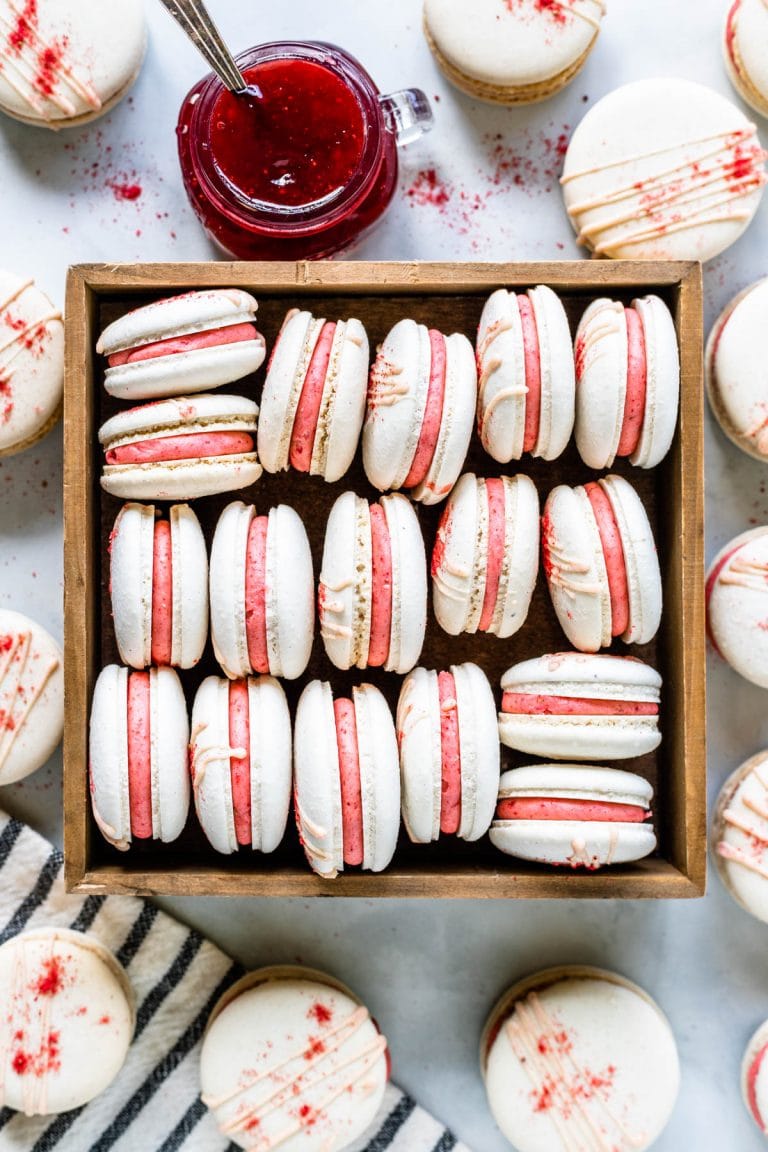
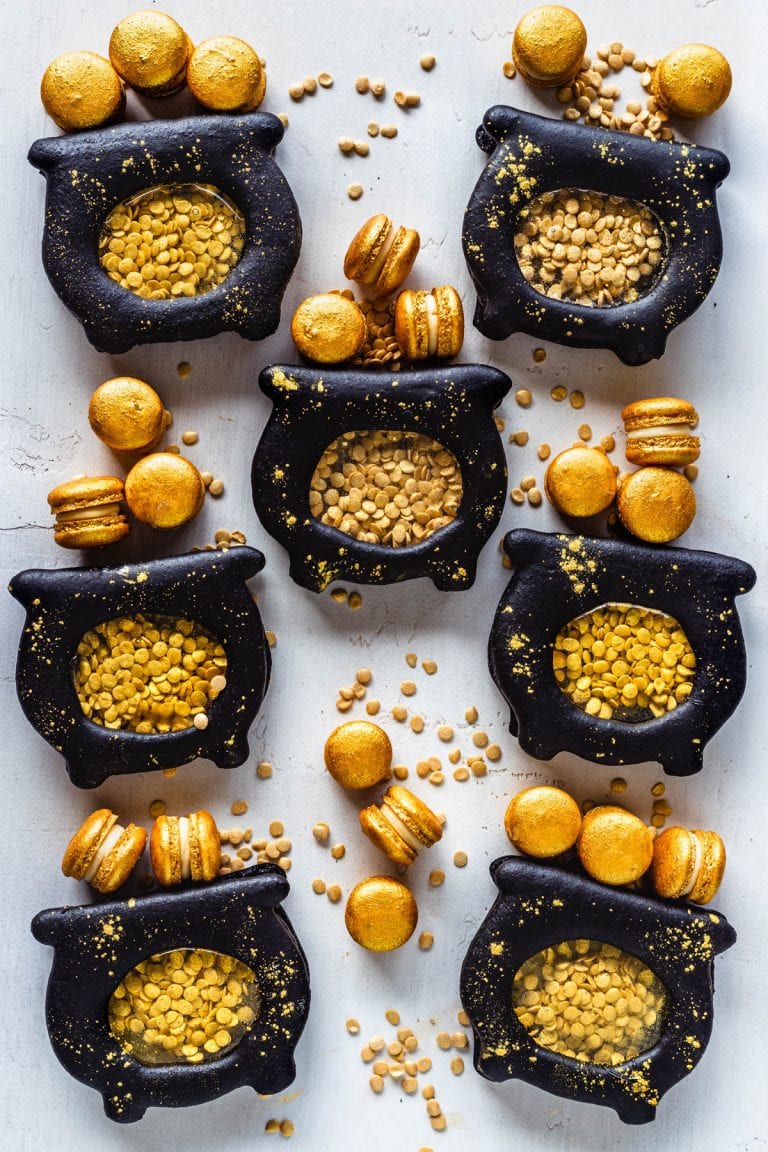
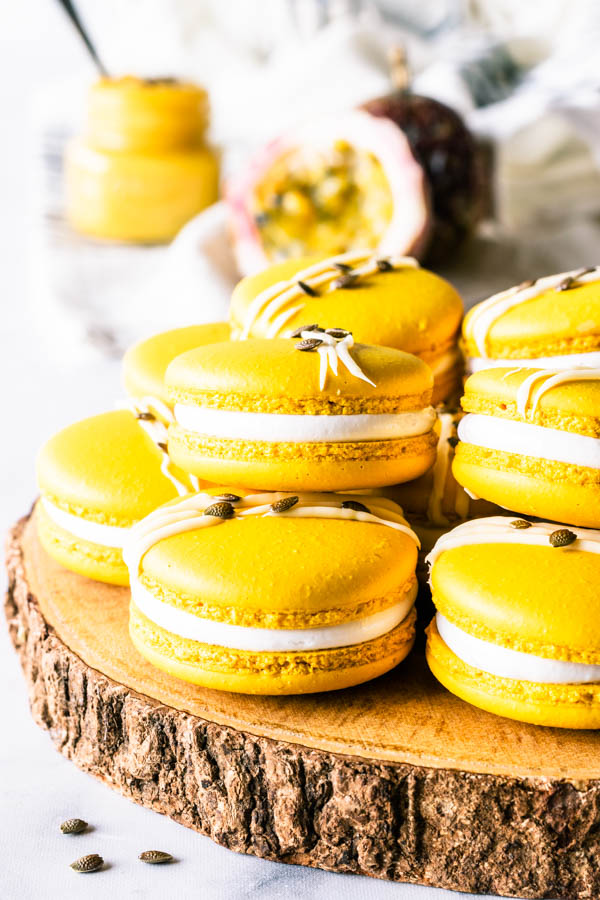
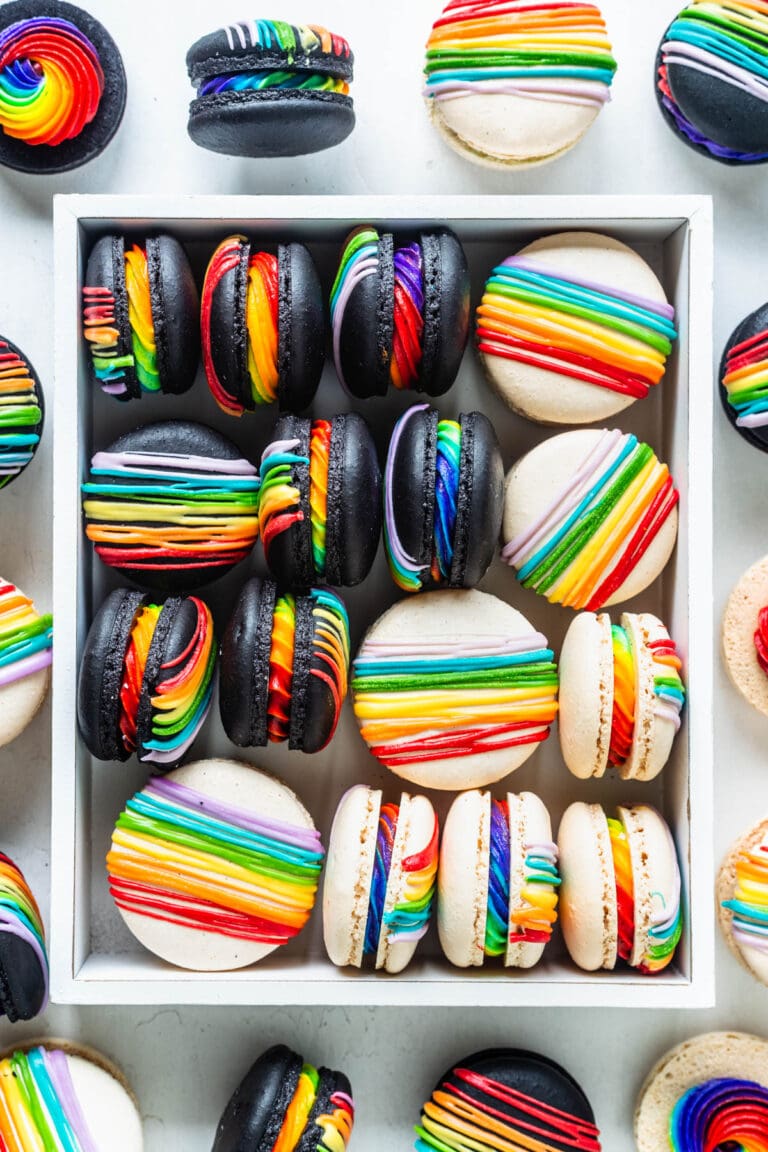
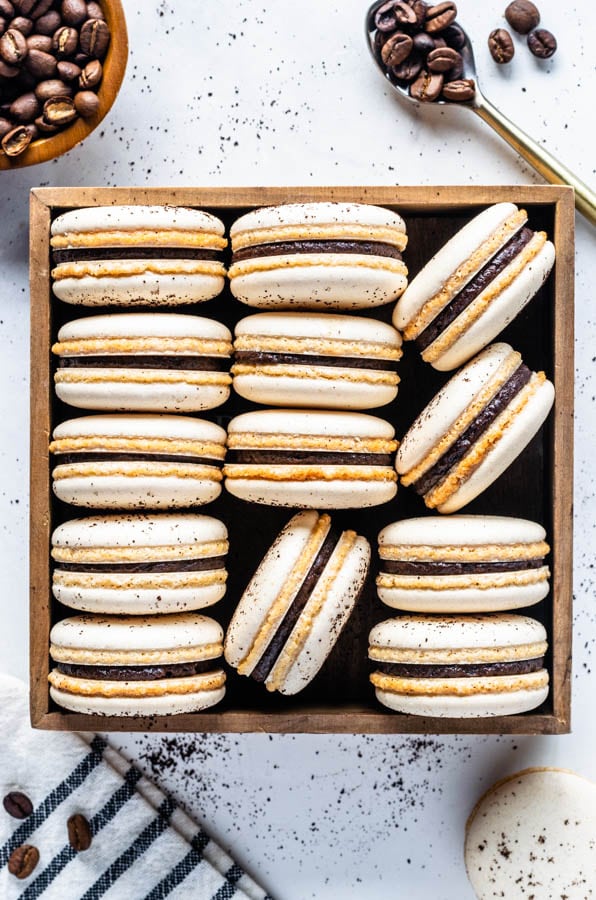

Seus macarons são sempre fantásticos!!!!!
Lindos e saborosos!!😋😋👏👏👏👏👏👏
That is so cute! I’m sure that is also delicious! Want to taste that one.
thanks so much
Hi Camila
Getting ready to make these this weekend. Last time I used hazelnut flour it was challenging. I’m going to follow your steps and know that I will have better success!
I’ve also been sticking with French meringue but feel bold enough to try Swiss. ☺️
If I don’t have egg white powder, should or can I use cream of tartar?
Thanks!
Nikki
You dont have to add cream of tartar. I’ve never added to my swiss meringue recipes, just to the french. Just skip the egg white powder and you should be fine 🙂
Hi Camilla
I’ve made this recipe now four times and every time my cookies at too crunchy. Changed out filling too.
So every time I add hazelnut flour in the cookies it makes them too hard and crunchy. Any suggestions? Omit egg white powder?
Should I lower temp or take the cookies out even if they wiggle a little bit?
You can omit the egg white powder yes. When it was winter back where I used to live the weather got super dry so egg white powder made my macarons extremely crunchy.
You can also try lowering the temperature, or baking a little less, but don’t take them out if they are still jiggly, bake until they are set.
Another trick for crunchy macarons is to put a slice of bread or a brown sugar bear inside the container with the macarons (but not directly touching them, put a layer of parchment or plastic wrap between them) and let them sit in the closed container overnight in the fridge. The macarons will soften up because will absorb moisture from the bread or sugar bear.